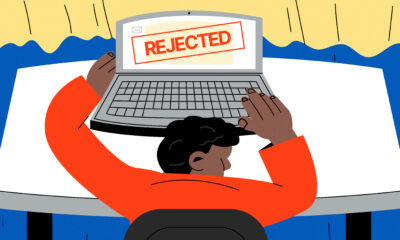Career
Adeleye Sinmi-Adetona: Getting Over Fear… 7 Steps to Help You Succeed
 I wrote this one to fight fear.
I wrote this one to fight fear.
Scientifically speaking, everyone is born with two types of fear; fear of loud sounds and the fear of falling. Other fears they say, are built into our circuitry as survival techniques and passed on from our ancestors, who lived in the primitive age.
The fear of closed spaces for instance, was a logical response to the fear of being caught in a cave at night and ending up as dinner as for pack of wolves on the hunt.
In modern times, this could translate to similar fears like the fear of elevators or the overpowering need to sit on the aisle in church or on the plane to have easy access to the exit in case of danger. (I’m not too certain about the exit on the plane though ?) Fear of closed spaces, fear of heights and even fear of the dark amongst others, scientists say have kept our species alive through the ages.
But what about these kinds of fears?
Fear of doing what you want
Fear of speaking up
Fear of trying something new
The fear of failure
Fear of not fitting in
Fear of messing up that deal
Fear of not being good enough
The fear of being successful
Where do they come from? My issue with these kinds of fear is that they hardly serve any purpose talk more of keeping us safe. They only stop us…stop me, from doing the things I want or need to do.
They incapacitate, kill dreams, lower potential and totally blind us to the extent of our ability.
I picked up my own fair share of fear while growing up. I have come face to face with them many times and in different forms in the last couple of years in my experience in entrepreneurship and growing a business.
Working in a Digital solutions and marketing company means we receive briefs for digital marketing or transformation projects from clients who intend to improve their business or product.
A brief is simply a problem statement from a brand or company identifying the challenges they face, where they are now and where they aim to get to.
Some briefs are simple and others more complex, usually depending on the size of the organization or the problem to be solved.
As you would guess, briefs from multi-national firms are usually large both in scope and the sheer volume of the document. Every brief requires a response or proposal showing how we intended to handle the problems and meet the clients’ needs and as experts our job is to present our proposal in very clear and concise terms.
Typically, in preparing our response, my team would start with a general discussion – what we know about the brand, our experience with the brand, bring up ideas off top of our heads and generally get really excited about the project. From then we move on to carry out in-depth research.
My team lead never lets off on this stage — our research always yields better insights into the problem and better ideas for a solution. The next step will be to create and define concepts around our ideas, solidify them into executable solutions and document them.
Usually we would need two strong complementing solutions and one supplementary one.
You would think that being somewhat accustomed to working on briefs would translate to a lot of confidence working on new projects. But no! After about six months since our last major project, here I am again, faced with another brief – anxious to bits and crippled by fear.
This brief is one of those huge, super detailed ones and probably very expensive too. What makes this brief particularly scary is that, unlike other briefs we were used to receiving, this one came because we actively solicited for it.
We said…I said, I can do this, I can build this sort of solution, we can solve these sorts of problems. We asked for it because we are experts – this is what we do. We create digital marketing solutions that can help brands reach their target audience and drive sales. We can do this…I can do this.
And it came. Finally, it came. I asked for it and I got it. And now I am afraid!
So, what I am on to with this piece? I am writing this with a goal to refine a methodology for tackling any fear inducing encounter.
Learning from past experiences, I will seek to develop an approach that will help undo the binding effect that comes with being afraid.
Hi Leye, here is the PROBLEM! Solve it.
Oh wow. Huge!!!
First, break it down.
A brief is like any other problem I have encountered and is made up of a combination of smaller chunks of problems that make up the whole. Being able to identify and break the problem statement into smaller functional sections is the first step to tackling the brief.
The objective at hand must first be identified and broken down into simpler bits — milestones, phases, and criteria for success. Hence, the What, Who, Why, and When questions come into play.
Answering these questions individually builds a foundation for the overall solution.
Team work
A balanced team is critical to a successful venture, while I admire the Rambos that go on solo missions but I find that I am most effective when I work with and in a team. No one is ever able to succeed at anything working alone. Teams give sustainability for the long run, with a team it is easy to divide the work and conquer.
Recall past victories
One reason I have learned, why every new level of challenge looks so daunting and impossible to surmount is because I fail to remember that I had repeatedly won many victories in the past.
I have taken up challenges I thought daunting, pitched in front of the most intimidating panel and been selected, planned & executed an event under limited time and financial resources, yet it was successful. If only I learned to recall these past victories, I’d have more confidence to take this new one on.
But those ‘past’ victories are nothing compared to the task at hand. I tell myself this, but my better self says; ‘You are bigger, better, tougher and stronger now to take on the task at hand. Your level of expertise or strength back then was just enough to take on those goals, and now you have what it takes for the task at hand’.
Start, with the simplest
There are cases where I have had to handle more than one sizeable chunk myself (this is mostly unavoidable) and I tend to want to take on the most difficult task at first.
This goes well at-times, but I find myself stuck trying to figure out this one thing. Call it creative block or its equivalent in your field, but a simple way to unblock is to find a quick win.
Go for the low hanging fruits and hit a quick win. The good feeling of being able to clear a task or hit a mini goal gives the impetus to scale over the unbreakable wall.
Celebrate little successes
Little successes help build confidence and highlights valuable lessons learned. I fail to remember my little successes mostly because I do not reward myself or celebrate the victories.
When I celebrate even the small ones, the memory is stronger. If I remember, then my confidence goes up, if I remember the details of those successes then, I know how to or how not to do it next time. Sometimes failures need to be ‘celebrated’, not in a joyous mode but a form of acknowledgement of a failed experiment. With notes, lessons and actions items.
Ask for help
I’ll admit that I need help sometimes, and everyone does now and then. I learn more from speaking to people, they offer fresh insights and perspective to the task at hand. Other times they just serve as a sounding board to help clarify my thoughts and ideas.
Get some rest/sleep
Sleep is a useful hack. Feel free to help your body and mind reset. Sleep, wake up and work at the problem again.
I always like a fresh start, and sleep offers just that – a power nap or few hours of deep rest do the magic.
The goal here isn’t to dispel fear as a myth but give clues on how to do what needs to be done despite fear.
First, breaking down the problem into its component part deconstructs the giant and makes it easy to tackle.
Next, working with other people means you get to work in your area of strength and tackle those parts that you have been trained for or those things you care about.
Wearing multiple hats is quite unavoidable, especially as a start-up. I’ve had to play accountant, graphics designer, communications & copywriter and work at business development at various times. The trick is to compartmentalize, and take up each role one at a time and then eventually wear the hat of a manager that brings all the pieces together.
A recall of past victories, no matter how little gives a boost of confidence. So, I choose to do a David, and count my victories with bears and lions:
• Hult Prize Global Challenge — 2012 Winner #TeamBabajide
• Japaul Group — First time Leading a B2B Digital Marketing Pitch 2015
• Guinness Digital Marketing Pitch — 2016: Biggest brief tackled, Real practical solutions developed
• French Tech Ticket 2017 Winner — VeriCampus, 1 of 70 selected of 1,000+ Global applications
What are your victories?
None? Impossible.
If you are lacking in memory then it’s easy to create one; go play a game of Candy Crush or angry birds, win, then give it meaning by celebrating your success.
It can provide the relaxing and confidence building feeling needed to tackle your present work.
Finally, tackling the simple tasks first help to unravel the more difficult tasks. These low hanging fruits serve as nourishment and their branches a foothold to higher goals.
How do these six steps help you get past the fear of doing what needs to be done? Break it down now, that is the first step.
Break it down.
1…
2…
3…
Photo Credit: Dreamstime | Сергей Толмачев























